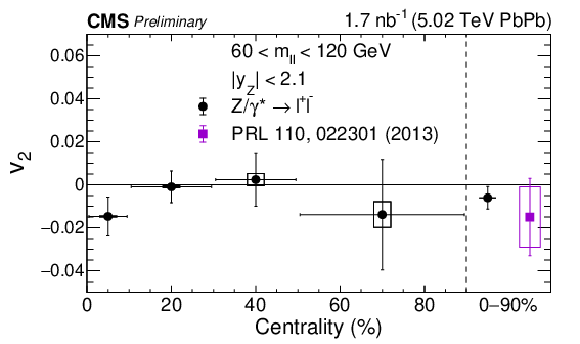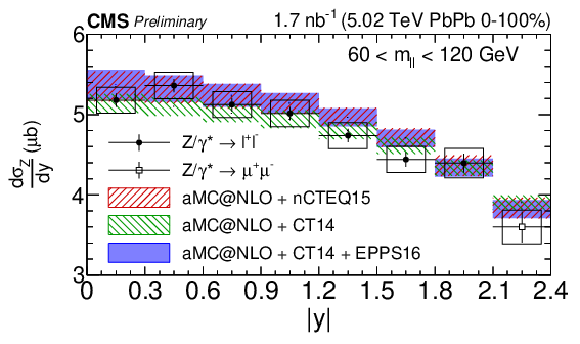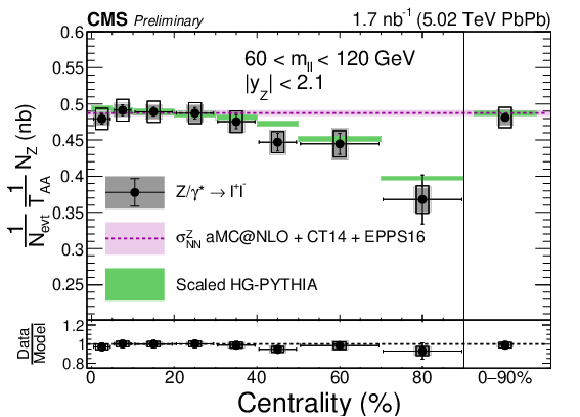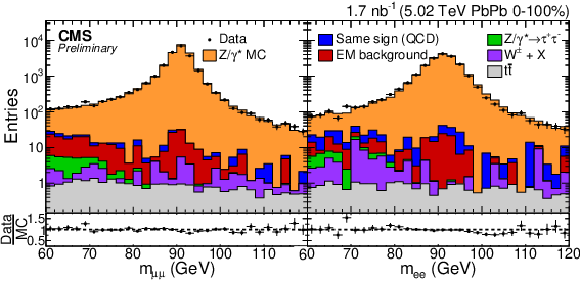

Compact Muon Solenoid
LHC, CERN
| CMS-PAS-HIN-19-003 | ||
| New constraints of initial states in PbPb collisions with Z boson yields and azimuthal anisotropy at √sNN= 5.02 TeV | ||
| CMS Collaboration | ||
| June 2020 | ||
| Abstract: The differential yields of Z bosons decaying to a pair of leptons are measured in PbPb collisions collected by the CMS experiment at the LHC. The measurements are performed for collisions at 5.02 TeV, using both the muon and electron decay channels. The yields in various centrality bins are compared to Glauber model predictions of the production rates of hard probes not modified by the presence of a hot medium. For the first time, Z boson yields in peripheral collisions are found to deviate from the canonical scaling expected for colorless hard probes, indicating the presence of initial collision geometry and centrality selection biases. Because the measurement uncertainties are comparable to the uncertainties of a Glauber-scaled reference, Z boson yields can now be used as an experimental measure of the effective nucleon-nucleon luminosity without loss of precision. A high precision measurement of the Z boson azimuthal anisotropy (v2) is also found to be compatible with zero, showing that Z bosons do not experience significant final-state modification in heavy ion collisions. | ||
|
Links:
CDS record (PDF) ;
CADI line (restricted) ;
These preliminary results are superseded in this paper, Submitted to PRL. The superseded preliminary plots can be found here. |
||
| Figures & Tables | Summary | Additional Figures | References | CMS Publications |
|---|
| Figures | |

png pdf |
Figure 1:
The v2 of Z bosons in PbPb collisions for various centrality bins. The error bars represent statistical uncertainties, while the boxes represent systematic uncertainties. A previous measurement by the ATLAS Collaboration at √sNN= 2.76 TeV is also shown [5]. |

png pdf |
Figure 2:
The Z boson differential cross section as a function of |y|. The error bars represent statistical uncertainties, while the boxes represent systematic uncertainties. Predictions using one PDF and two nPDF sets are also shown. The width of the model bands represents the contribution from PDF uncertainties, as well as the TAA uncertainty. |

png pdf |
Figure 3:
The Z boson differential cross section as a function of pT. The error bars represent statistical uncertainties, while the boxes represent systematic uncertainties. Predictions using one PDF and two nPDF sets are also shown. The bottom panel shows a ratio of the predictions to data. The width of the model bands represents the contribution from PDF uncertainties, as well as the TAA uncertainty. |

png pdf |
Figure 4:
The TAA-scaled yields of Z bosons as a function of centrality. The error bars, hollow boxes, and solid gray boxes represent the statistical, systematic, and TAA uncertainties, respectively. The value of σZNN and the HG-PYTHIA model are shown for comparison, with the width of the bands representing nPDF uncertainties. |
| Tables | |

png pdf |
Table 1:
TAA values for √sNN= 5.02 TeV PbPb collisions. The uncertainties result from uncertainties in the model parameters and the HF detector energy resolution. |
| Summary |
| In summary, high precision Z boson yields and elliptic flow coefficient (v2) have been measured as a function of centrality in lead-lead collisions at a center-of-mass energy per nucleon-nucleon pair of 5.02 TeV. The Z boson v2 is compatible with zero, consistent with the expectation of no significant final-state modifications experienced by Z bosons from the presence of a quark-gluon plasma. The differential cross section of Z bosons is found to agree with a model including two different nuclear parton distributions as a function of rapidity. However, some discrepancies are observed as a function of transverse momentum. Appropriately scaled Z boson yields have a flat trend as a function of centrality in the 0--40% range. A decreasing trend is seen for the first time toward more peripheral events. This trend is compatible with the HG-PYTHIA model which considers initial collision geometry and centrality selection biases. Results presented in this note provide a new data-driven proxy for estimating the average nucleon-nucleon luminosity of a heavy ion collision. This quantity could avoid uncertainties in Glauber modeling and account for potential biases related to event selection and centrality calibration. Such a method paves the way for searching for the onset of hot medium effects on colored hard probes in peripheral and small-system collision events in the future. |
| Additional Figures | |

png pdf |
Additional Figure 1:
The dilepton mass distributions in both the muon (left) and electron (right) channels for the 0-100% centrality range. The data are shown by the black points, and are compared to Monte Carlo signal and background predictions shown by the colored histograms. The Monte Carlo is normalized using the theoretical cross section of the process multiplied by the integrated luminosity of the data. A ratio of the data and Monte Carlo is shown in the bottom panels. |
| References | ||||
| 1 | J. Bjorken | Energy Loss of Energetic Partons in Quark - Gluon Plasma: Possible Extinction of High pT Jets in Hadron - Hadron Collisions | FERMILAB-PUB-82-059-T | |
| 2 | D. d'Enterria | Jet quenching | Landolt-Bornstein 23 (2010) 471 | 0902.2011 |
| 3 | M. L. Miller, K. Reygers, S. J. Sanders, and P. Steinberg | Glauber modeling in high energy nuclear collisions | Ann. Rev. Nucl. Part. Sci. 57 (2007) 205 | nucl-ex/0701025 |
| 4 | CMS Collaboration | Study of Z production in PbPb and pp collisions at √sNN= 2.76 TeV in the dimuon and dielectron decay channels | JHEP 03 (2015) 022 | CMS-HIN-13-004 1410.4825 |
| 5 | ATLAS Collaboration | Measurement of Z boson Production in Pb+Pb Collisions at √sNN= 2.76 TeV with the ATLAS Detector | PRL 110 (2013) 022301 | 1210.6486 |
| 6 | ATLAS Collaboration | Z boson production in Pb+Pb collisions at √sNN= 5.02 TeV measured by the ATLAS experiment | PLB 802 (2020) 135262 | 1910.13396 |
| 7 | ALICE Collaboration | Z-boson production in p-Pb collisions at √sNN= 8.16 TeV and Pb-Pb collisions at √sNN= 5.02 TeV | 2005.11126 | |
| 8 | ATLAS Collaboration | Measurement of W± boson production in Pb+Pb collisions at √sNN= 5.02 TeV with the ATLAS detector | EPJC 79 (2019) 935 | 1907.10414 |
| 9 | CMS Collaboration | Study of W boson production in PbPb and pp collisions at √sNN= 2.76 TeV | PLB 715 (2012) 66 | CMS-HIN-11-008 1205.6334 |
| 10 | ALICE Collaboration | Direct photon production in Pb-Pb collisions at √sNN= 2.76 TeV | PLB 754 (2016) 235 | 1509.07324 |
| 11 | ATLAS Collaboration | Centrality, rapidity and transverse momentum dependence of isolated prompt photon production in lead-lead collisions at √sNN= 2.76 TeV measured with the ATLAS detector | PRC 93 (2016) 034914 | 1506.08552 |
| 12 | CMS Collaboration | Measurement of isolated photon production in pp and PbPb collisions at √sNN= 2.76 TeV | PLB 710 (2012) 256 | CMS-HIN-11-002 1201.3093 |
| 13 | K. Dusling, W. Li, and B. Schenke | Novel collective phenomena in high-energy proton-proton and proton-nucleus collisions | Int. J. Mod. Phys. E 25 (2016) 1630002 | 1509.07939 |
| 14 | J. L. Nagle and W. A. Zajc | Small System Collectivity in Relativistic Hadronic and Nuclear Collisions | Ann. Rev. Nucl. Part. Sci. 68 (2018) 211 | 1801.03477 |
| 15 | M. Luzum and J.-Y. Ollitrault | Eliminating experimental bias in anisotropic-flow measurements of high-energy nuclear collisions | PRC 87 (2013) 044907 | 1209.2323 |
| 16 | CMS Collaboration | The CMS trigger system | JINST 12 (2017) P01020 | CMS-TRG-12-001 1609.02366 |
| 17 | CMS Collaboration | The CMS experiment at the CERN LHC | JINST 3 (2008) S08004 | CMS-00-001 |
| 18 | C. Loizides, J. Kamin, and D. d'Enterria | Improved Monte Carlo Glauber predictions at present and future nuclear colliders | PRC 97 (2018) 054910 | 1710.07098 |
| 19 | J. Alwall et al. | The automated computation of tree-level and next-to-leading order differential cross sections, and their matching to parton shower simulations | JHEP 07 (2014) 079 | 1405.0301 |
| 20 | R. Frederix and S. Frixione | Merging meets matching in MC@NLO | JHEP 12 (2012) 061 | 1209.6215 |
| 21 | K. J. Eskola, P. Paakkinen, H. Paukkunen, and C. A. Salgado | EPPS16: Nuclear parton distributions with LHC data | EPJC 77 (2017) 163 | 1612.05741 |
| 22 | S. Dulat et al. | New parton distribution functions from a global analysis of quantum chromodynamics | PRD 93 (2016) 033006 | 1506.07443 |
| 23 | T. Sjostrand, S. Mrenna, and P. Z. Skands | A Brief Introduction to PYTHIA 8.1 | CPC 178 (2008) 852 | 0710.3820 |
| 24 | T. Sjostrand et al. | An Introduction to PYTHIA 8.2 | CPC 191 (2015) 159 | 1410.3012 |
| 25 | CMS Collaboration | Extraction and validation of a new set of CMS PYTHIA8 tunes from underlying-event measurements | CMS-GEN-17-001 1903.12179 |
|
| 26 | I. P. Lokhtin and A. M. Snigirev | A Model of jet quenching in ultrarelativistic heavy ion collisions and high-p(T) hadron spectra at RHIC | EPJC 45 (2006) 211 | hep-ph/0506189 |
| 27 | GEANT4 Collaboration | GEANT4: A Simulation toolkit | NIMA 506 (2003) 250 | |
| 28 | CMS Collaboration | Particle-flow reconstruction and global event description with the CMS detector | JINST 12 (2017) P10003 | CMS-PRF-14-001 1706.04965 |
| 29 | CMS Collaboration | Performance of the CMS muon detector and muon reconstruction with proton-proton collisions at √s= 13 TeV | JINST 13 (2018) P06015 | CMS-MUO-16-001 1804.04528 |
| 30 | CMS Collaboration | Performance of Electron Reconstruction and Selection with the CMS Detector in Proton-Proton Collisions at √s= 8 TeV | JINST 10 (2015) P06005 | CMS-EGM-13-001 1502.02701 |
| 31 | A. Hocker et al. | TMVA - Toolkit for Multivariate Data Analysis | physics/0703039 | |
| 32 | CMS Collaboration | Measurements of Inclusive W and Z Cross Sections in pp Collisions at √s= 7 TeV | JHEP 01 (2011) 080 | CMS-EWK-10-002 1012.2466 |
| 33 | Particle Data Group Collaboration | Review of particle physics | PRD 98 (2018) 030001 | |
| 34 | CMS Collaboration | Evidence for light-by-light scattering and searches for axion-like particles in ultraperipheral PbPb collisions at √sNN= 5.02 TeV | PLB 797 (2019) 134826 | CMS-FSQ-16-012 1810.04602 |
| 35 | S. R. Klein et al. | STARlight: A Monte Carlo simulation program for ultra-peripheral collisions of relativistic ions | CPC 212 (2017) 258 | 1607.03838 |
| 36 | T. Adye | Unfolding algorithms and tests using RooUnfold | in Proceedings, PHYSTAT 2011 Workshop on Statistical Issues Related to Discovery Claims in Search Experiments and Unfolding, CERN 2011 | 1105.1160 |
| 37 | CMS Collaboration | Measurement of prompt D0 meson azimuthal anisotropy in Pb-Pb collisions at √sNN= 5.02 TeV | PRL 120 (2018) 202301 | CMS-HIN-16-007 1708.03497 |
| 38 | A. M. Poskanzer and S. A. Voloshin | Methods for analyzing anisotropic flow in relativistic nuclear collisions | PRC 58 (1998) 1671 | nucl-ex/9805001 |
| 39 | NA49 Collaboration | Directed and elliptic flow of charged pions and protons in Pb + Pb collisions at 40-A-GeV and 158-A-GeV | PRC 68 (2003) 034903 | nucl-ex/0303001 |
| 40 | J. Butterworth et al. | PDF4LHC recommendations for LHC Run II | JPG 43 (2016) 023001 | 1510.03865 |
| 41 | A. Valassi | Combining correlated measurements of several different physical quantities | NIMA 500 (2003) 391 | |
| 42 | K. Kovarik et al. | nCTEQ15 - Global analysis of nuclear parton distributions with uncertainties in the CTEQ framework | PRD 93 (2016) 085037 | 1509.00792 |
| 43 | H. Paukkunen | Nuclear PDFs in the beginning of the LHC era | NP A 926 (2014) 24 | 1401.2345 |
| 44 | C. Loizides and A. Morsch | Absence of jet quenching in peripheral nucleusnucleus collisions | PLB 773 (2017) 408 | 1705.08856 |
| 45 | CMS Collaboration | Charged-particle nuclear modification factors in XeXe collisions at √sNN= 5.44 TeV | JHEP 10 (2018) 138 | CMS-HIN-18-004 1809.00201 |
| 46 | ALICE Collaboration | Analysis of the apparent nuclear modification in peripheral Pb-Pb collisions at 5.02 TeV | PLB 793 (2019) 420 | 1805.05212 |
| 47 | M. Gyulassy and X.-N. Wang | HIJING 1.0: A Monte Carlo program for parton and particle production in high-energy hadronic and nuclear collisions | CPC 83 (1994) 307 | nucl-th/9502021 |

|
Compact Muon Solenoid LHC, CERN |

|

|

|

|

|

|